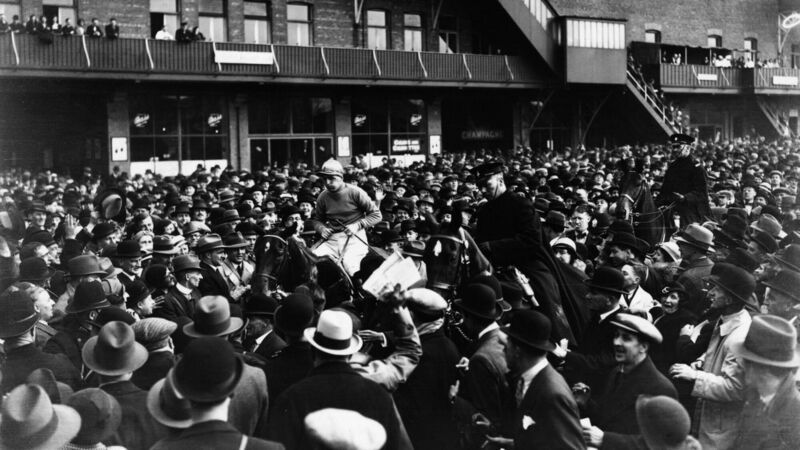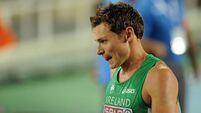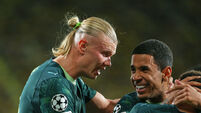Paul Rouse: How National Hunt became part of Irish identity

Golden Miller, ridden by Gerry Wilson being led in by owner Dorothy Paget after winning the Grand National at Aintree, near Liverpool. (Photo by Central Press/Getty Images)
An outstanding new book by Frances Nolan gives a unique insight into the place of the horse in Irish life. In its conception, its research, its writing and its presentation, it is of the very highest quality.
On page after page, the book – – reveals how important horse racing has been to social and cultural life on this island. This is a love which prospers generation after generation and shows no sign of diminishing.
Here is what Frances Nola had to say about the book this week:
The first recorded steeplechase took place in Cork in 1752, to satisfy a wager made by two huntsmen, but the sport began to formalise more in the 19th century and eventually steeplechase courses were built - first in England and then in Ireland. The Irish people - both the elite and the peasantry - loved horse racing and it was understood to be Ireland’s national sport before the establishment of the GAA in the late 19th century. Steeplechasing was particularly popular with the Irish, and they flocked in their thousands to racecourses across the island to thrill at the sight of horses and jockeys in full flight.
Equestrian sport was very closely associated with the Anglo-Irish - so much so that Brendan Behan once described an Anglo-Irishman as ‘a Protestant with a horse’. That association was rooted in the English colonisation of the island in the 17th century. English settlers were responsible for the early organisation of horse racing and it was from them that the Anglo-Irish landlord class descended.
The penal laws prohibited Catholics from owning horses valued at £5 or more - this was to limit the threat of military action but it also served to discourage Catholics from owning high quality horses for racing. They nonetheless found ways to indulge their love of the sport - some wealthier Catholics colluded with Protestant neighbours and friends to race good horses in high value races, but most entered horses in low value, or ‘small purse’ contests, which were open to horses worth less than £5.
These low value meetings were hugely popular in the 19th century, and were held all over the island. And if people couldn’t participate in the sport, they could enjoy racing as spectators at small and large meetings. Tens of thousands of people regularly thronged major meetings, like the annual festival at Punchestown, in the nineteenth century. Rich and poor, young and old, Catholic and Protestant – all travelled to thrill at the frantic procession of the steeplechase.
Were the Anglo-Irish the people who formed regulatory bodies, created modern point-to-point racing through hunt clubs, and bred and owned the best horses?
Horse racing reflected Irish society from the 18th to the early 20th century: the Anglo-Irish were the political, social and economic elite, and so they bred, owned and raced the best horses and were responsible for the regulation of horse racing at the highest level. They established the Turf Club in 1784 (succeeding earlier bodies) and the Irish National Hunt Steeplechase Committee in 1870 and they founded and populated hunt clubs across the island. So racing at the top level was exclusive for a long time, but it must also be recognised that the Anglo-Irish modernised the sport in Ireland and laid the foundations for the many successes that followed.
In some ways, racing has always been the sport of the people, because the Irish have always had a real love for horses and a passion for the sport they make possible. For most of its history, Ireland was a rural society and horse racing is, of course, a sport that was (and still is) firmly rooted in the land. Racing was at the centre of the social calendar for many communities, with meetings traditionally held on fair days or holy days, which allowed the Irish peasantry to attend. Low value races allowed people who owned lower quality horses to compete, while for those who could not afford it, horse ownership was something to aspire to. Steeplechasing captured the imagination of the Irish in a way that Flat racing did not and, by the second half of the 19th century, it truly was the sport of the people.
Yes, for a long time I think so. That is not surprising, given its close association with the Anglo-Irish ruling class. But racing also had, and still has, a profound power to unite people. This was recognised by WB Yeats, who wrote ‘At Galway Races’ in 1908 and who recognised that racing inspired what he so desired for the arts: a unity of culture. The immediacy of the sport - the majesty of the horses, the skill and courage of the riders, the sheer unpredictability - was intoxicating and had the potential to dissolve differences. As Yeats put it: ‘There where the course is, Delight makes all of the one mind’.
In large part, horse racing remained an all-Ireland sport after partition because it was economically important, as a shop window for Irish bloodstock. It made sense to regulate the sport without a border and that circumstance has contributed enormously to the success of Irish racing. It’s also important to recognise the importance of racing in realising a plural society after 1921.
The Anglo-Irish were responsible for racing’s development in Ireland; they formalised and modernised the sport and they were best placed to ensure its success on the island after partition. W.T. Cosgrave - leader of the Free State government and a keen huntsman himself - recognised this fact and he appointed members of the Anglo-Irish community to the first Seanad.
Horse racing, and National Hunt in particular, is still very strongly connected to Irish identity and Ireland is recognised as a site of excellence in the production of bloodstock and in the development of brilliant and highly successful racehorses. Economically, the thoroughbred industry is enormously important to Ireland - it’s worth almost €1.5 billion annually to the economy. It’s a really important source of employment, particularly in rural communities.
It has to be the story of Golden Miller, who was foaled by Laurence Geraghty (Barry’s grandfather) in 1927, only five minutes from where I grew up in County Meath. Like many other Irish-bred horses at the time, he was sold into England, to trainer Basil Briscoe. Golden Miller was so bedraggled from the journey across the Irish Sea that Briscoe compared him to a porcupine. He was briefly owned by Philip Carr but was sold (after Carr’s death) to the eccentric American millionaire, Dorothy Paget in 1931. Paget had just employed Briscoe as her private trainer, and together they proved that Golden Miller was anything but a porcupine! A truly incredible horse, he won the first of five consecutive Gold Cups at Cheltenham in 1932 and he became the first horse to win the Gold Cup-Grand National double in 1934. It blows my mind to think his story started just down the road from my childhood home!
Yes, I think so. Like many other sports in the modern era, racing faces challenges and it will require commitment, care and continuing evolution to ensure its future success in Ireland. But the racing community is very strong here and there is no shortage of commitment and care from those involved at all levels of the sport. And importantly, I think Irish people are still captivated by the spectacle of jump racing and they are still drawn to race meetings across the island. So there are challenges to overcome, but the roots are deep, the foundations are strong.



